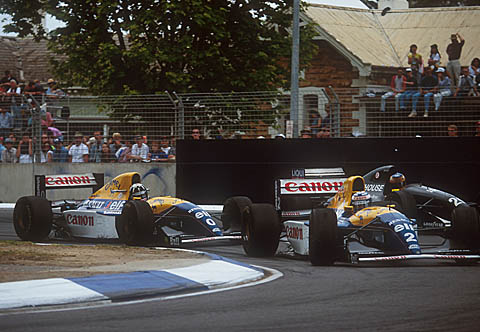


05/04/2013
FEATURE BY JIM CASEY
 |
The most advanced Formula One cars ever built are not running today. They ran 20 years ago, in 1993, when designers and engineers had relatively free reign to use technology to make the cars go faster. The cars had anti-lock brakes, stability and traction control, active suspension, and about 800 horsepower. These technological advances, except for the 800 horsepower 3.5 litre V-10 engines, quickly found their way on to road cars, but at the end of 1993, they were banned from Formula One.
Many say they were banned because Ferrari was slow to catch on and develop its own ABS, active suspension, etc., and perhaps that's true, but what matters is the path not taken. What kind of F1 cars would we have today, and what kinds of things might be on our road cars, that we have not yet seen.
The dominant car of that 1993 season was the Williams FW15C, designed by Adrian Newey. Yes, he has been around quite a while. The cars were driven by Damon Hill and Alain Prost, after 1992 World Champion Nigel Mansell chose to take his talents to the US and drive for the Newman-Haas CART Team. Williams dominated the season, winning 10 races and the Constructors' Championship, and Alain Prost winning the Drivers' Championship.
Though all of the teams were working on these various electronic aids, Williams was well ahead of everyone else, and its qualifying times were consistently 1-2 seconds quicker than its closest rivals, Ayrton Senna in the McLaren and Michael Schumacher in the Benetton. How much did these driver aids affect car performance? Damon Hill's pole time for that year's Italian Grand Prix at Monza remains the fastest lap for that particular configuration of the track, which lasted until 2002, when the pit straight chicane was changed to its current layout. The Williams-Renault FW15C also had a push-to-pass feature that allowed the driver to hit a button which gave an extra 300 engine revs, and raised the rear of the car to let air flow more freely past the diffuser at the rear of the car. The pole time set by Alain Prost in Hungary stood as the fast lap for 8 years, not a common occurrence in Formula One.
Some felt that these cars were too easy to drive, and that the drivers should not have so much electronic assistance. But isn't that what Formula One is supposed to be about? The people who run and market the series always tout it as the most technologically advanced series on the planet, so why did they change the regulations after the 1993 season to slow the advancement of technology in their own sport? Ferrari team was slower to develop its ABS, traction control, etc., so it protested the new developments, but it seems clear it would have caught up by the next season. Perhaps economics were involved, as the development of these electronics was expensive, and it took three computers just to get the Williams cars started at the beginning of each session. These were also the first generation of cars to transmit telemetry back to the pits as they finished each lap, and adjustments could be made to the car's suspension and engine from the pits as well.
If the advancements then in place had continued to develop, how much sooner would something like KERS have come along? How much more sophisticated would the traction controls and ABS in our road cars be, if they had continued to be developed in the cauldron of competition? How would twenty more years of development of active suspension affect the way the Pirelli tires are wearing on today's cars, and how much more fun might our road cars be to drive with similar suspension technology?
Trying to legislate away the advancements of science has always been a fool's errand, no matter the arena. But almost every sanctioning body in racing seems determined to try, at least to a degree, which has brought us all these spec series.
If you weren't following Formula One in 1993 and didn't see those amazing cars race, fortunately there are plenty of clips on Youtube. Watch and enjoy.
Jim Casey
jim.casey@pitpass.com
To check out previous features from Jim, click here